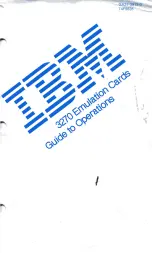
114
CHAPTER 3 CPU
Table 3.7-1 Functions of clock select register (CKSCR) (1/2)
bit name
Function
bit9
bit8
CS1, CS0:
the multiplication rate
select bits
The PLL clock multiplier is selected from among seven options depending on the combination of
PSCCR: CS2 and CKSCR: CS1/CS0.
Any reset causes the bit to return to the reset value.
Note:
When the PLL clock is selected (CKSCR: MCS = 0), writing is inhibited.To change the
multiplier, write 1 to the PLL clock select bit (CKSCR: MCS), update the multiplier select bits
(CKSCR: CS1, CS0), then set the PLL clock select bit (CKSCR: MCS) back to 0.
bit10
MCS:
PLL clock select bit
This bit indicates the main clock or PLL clock to be selected as the machine clock.
When the machine clock is switched from the main clock to the PLL clock (CKSCR: MCS = 1
→
),
the clock mode changes from main clock mode to PLL clock mode after the PLL clock oscillation
stabilization wait time is generated.The timebase timer is cleared automatically.The oscillation
stabilization wait time taken when the clock mode is switched from main clock to PLL clock is
fixed at 214/HCLK (about 4.1 ms during operation at an oscillation clock frequency of 4 MHz).The
oscillation stabilization wait time taken when the machine clock is switched from subclock mode to
PLL clock mode follows the values specified in the oscillation stabilization wait time select bits
(CKSCR: WS1, WS0).
Any reset causes the bit to return to the reset value.
Note:
1) When both of the MCS and SCS bits contain 0, the SCS bit supersedes the MCS bit,
thereby setting the subclock mode.
2) When switching from the main clock to PLL clock (CKSCR: MCS = 1
→
0), use the
timebase timer interrupt enable bit (TBTC: TBIE) or interrupt level mask register (ILM:
ILM2 to 0) to disable timebase timer interrupts before writing 0 to the PLL clock select
bit.
bit11
SCS:
sub clock selection bit
This bit indicates the main clock or sub clock to be selected as the machine clock.
•
When the machine clock is switched from the main clock to the subclock (CKSCR: SCS = 1 ->
0), the main clock mode changes to the subclock mode in synchronization with the subclock
(about 130
µ
s).
•
When the machine clock is switched from the subclock to the main clock (CKSCR: SCS = 0 ->
1), the clock mode changes from subclock mode to main clock mode after the main clock
oscillation stabilization wait time is generated.Timebase timer is cleared automatically.
Any reset causes the bit to return to the reset value.
Note:
1) When both of the MCS and SCS bits contain 0, the SCS bit supersedes the MCS bit,
thereby setting the subclock mode.
2) If both the subclock select bit (CKSCR: MCS) and PLL clock select bit (CKSCR: SCS)
contain 0, the subclock is preferred.
3) When switching from the main clock to subclock (CKSCR: SCS = 1
→
0), use the
timebase timer interrupt enable bit (TBTC: TBIE) or interrupt level mask register (ILM:
ILM2 to 0) to disable timebase timer interrupts before writing 0 to the subclock select bit.
4) The sub clock oscillation stabilization wait time (approximately 2 s) is generated at
power on or at cancellation of the stop mode.
If the clock mode is switched from main clock
mode to subclock mode, therefore, the oscillation stabilization wait time is generated.
5) There is no sub-clock in MB90F897S.
Set the initial value.
Summary of Contents for F2MC-16LX Series
Page 2: ......
Page 3: ...FUJITSU LIMITED F2MC 16LX 16 bit Microcontroller MB90895 series Hardware Manual ...
Page 4: ......
Page 8: ...iv ...
Page 10: ...vi ...
Page 36: ...18 CHAPTER 2 HANDLING DEVICES ...
Page 176: ...158 CHAPTER 3 CPU ...
Page 224: ...206 CHAPTER 5 Timebase timer ...
Page 294: ...276 CHAPTER 8 16 bit reload timer ...
Page 366: ...348 CHAPTER 12 DTP external interrupt ...
Page 398: ...380 CHAPTER 13 8 10 bit A D converter ...
Page 446: ...428 CHAPTER 14 UART0 ...
Page 588: ...570 CHAPTER 17 Address Match Detecting Function ...
Page 626: ...608 CHAPTER 19 512 KBIT FLASH MEMORY ...
Page 676: ...658 APPENDIX Table A 9 3 Bit Operation Instruction Map first byte 6CH ...
Page 678: ...660 APPENDIX Table A 9 5 2 byte Instruction Map first byte 6FH MUL MULW DIVU A A A ...
Page 680: ...662 APPENDIX Table A 9 7 ea Instruction 2 first byte 71H ...
Page 681: ...663 APPENDIX A Instructions Table A 9 8 ea Instruction 3 first byte 72H ...
Page 682: ...664 APPENDIX Table A 9 9 ea Instruction 4 first byte 73H ...
Page 683: ...665 APPENDIX A Instructions Table A 9 10 ea Instruction 5 first byte 74H ...
Page 684: ...666 APPENDIX Table A 9 11 ea Instruction 6 first byte 75H ...
Page 685: ...667 APPENDIX A Instructions Table A 9 12 ea Instruction 7 first byte 76H ...
Page 686: ...668 APPENDIX Table A 9 13 ea Instruction 8 first byte 77H ...
Page 687: ...669 APPENDIX A Instructions Table A 9 14 ea Instruction 9 first byte 78H ...
Page 688: ...670 APPENDIX Table A 9 15 MOVEA RWi ea Instruction first byte 79H ...
Page 689: ...671 APPENDIX A Instructions Table A 9 16 MOV Ri ea Instruction first byte 7AH ...
Page 690: ...672 APPENDIX Table A 9 17 MOVW RWi ea Instruction first byte 7BH ...
Page 691: ...673 APPENDIX A Instructions Table A 9 18 MOV ea Ri Instruction first byte 7CH ...
Page 692: ...674 APPENDIX Table A 9 19 MOVW ea Rwi Instruction first byte 7DH ...
Page 693: ...675 APPENDIX A Instructions Table A 9 20 XCH Ri ea Instruction first byte 7EH ...
Page 694: ...676 APPENDIX Table A 9 21 XCHW RWi ea Instruction first byte 7FH ...
Page 710: ......
















































